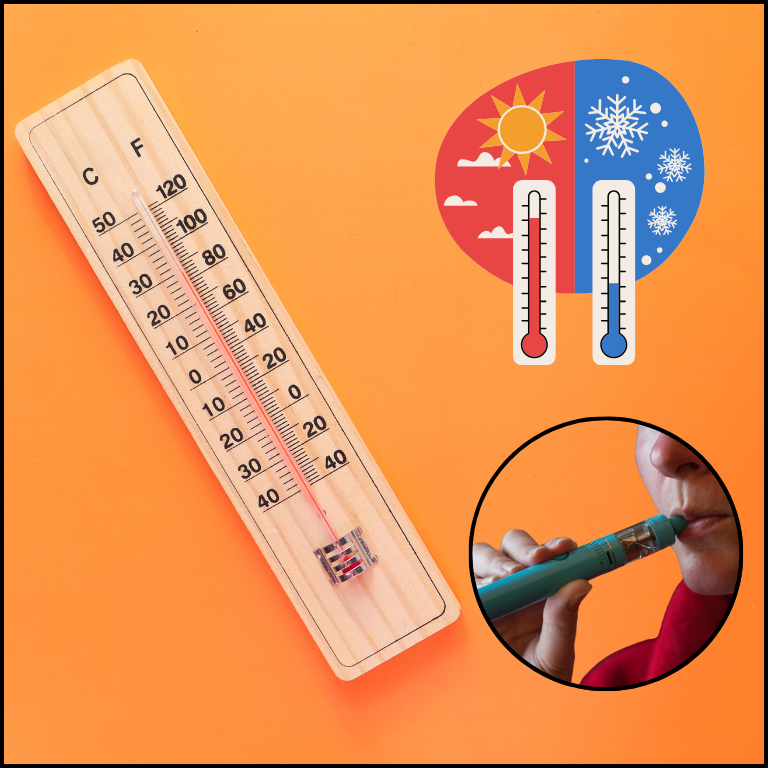Cannabis Vaping Temperatures: Science, Safety, and Enjoyment

The popularity of cannabis vaping has surged in recent years, largely due to its perceived health benefits over smoking, as well as the ability to control and enhance the experience through temperature regulation. Vaping allows users to heat cannabis to specific temperatures, releasing various cannabinoids and terpenes without combustion, which can produce harmful byproducts. However, the relationship between temperature, the release of compounds, and user safety and satisfaction is complex and requires a deeper understanding. This article delves into the science of cannabis vaping temperatures, exploring how different heat levels affect the vaping experience, the safety implications, and how to achieve the best balance for enjoyment and health.
The Science of Cannabis Vaping
Vaping cannabis involves heating the plant material or concentrates to a temperature where the active compounds—cannabinoids and terpenes—are vaporized without burning the plant matter. Unlike smoking, which can reach temperatures above 1000°F (537°C), vaping typically occurs between 300°F (149°C) and 450°F (232°C). This temperature range is crucial because it influences which compounds are released and how they interact with the body.
Understanding Cannabinoids and Terpenes
Cannabinoids like THC (tetrahydrocannabinol) and CBD (cannabidiol) are the primary active compounds in cannabis, responsible for its psychoactive effects and therapeutic benefits. Terpenes are aromatic compounds that contribute to the plant’s flavor and scent, and they also play a role in the effects of cannabis by modulating the impact of cannabinoids—a phenomenon known as the “entourage effect.”
Different cannabinoids and terpenes vaporize at specific temperatures. For instance, THC begins to vaporize at around 315°F (157°C), while CBD requires slightly higher temperatures, starting at about 356°F (180°C). Terpenes have an even broader range of vaporization points, from 310°F (154°C) for myrcene, a sedative terpene, to 388°F (198°C) for linalool, which is known for its calming effects.
Low-Temperature Vaping: Flavor and Subtle Effects
Vaping at lower temperatures, typically between 300°F (149°C) and 350°F (177°C), is ideal for those seeking a flavorful and mild experience. At these temperatures, the vapor is rich in terpenes, providing a pronounced aroma and taste that reflects the strain’s unique profile. The effects tend to be more cerebral and less intense, as the lower temperatures may not fully activate all cannabinoids, particularly THC.
For users who prioritize flavor over potency, low-temperature vaping offers a more nuanced experience. It’s also a good option for those who prefer the therapeutic benefits of terpenes without the stronger psychoactive effects of higher THC levels.
Mid-Temperature Vaping: Balanced Effects
Vaping at mid-range temperatures, typically between 350°F (177°C) and 400°F (204°C), strikes a balance between flavor and potency. At these temperatures, both cannabinoids and terpenes are effectively vaporized, offering a well-rounded experience that includes both the flavor of the terpenes and the effects of cannabinoids like THC and CBD.
This temperature range is often preferred by those who want a more substantial psychoactive experience without sacrificing too much flavor. It’s also a sweet spot for medical users who need both the therapeutic effects of cannabinoids and the potential benefits of terpenes.
High-Temperature Vaping: Maximum Potency
Vaping at higher temperatures, typically between 400°F (204°C) and 450°F (232°C), maximizes the release of cannabinoids, resulting in a more potent experience. At these temperatures, nearly all the active compounds in cannabis are vaporized, including higher-boiling-point cannabinoids and terpenes.
However, the trade-off is that the vapor may be harsher, and some of the more delicate terpenes can be degraded, resulting in less flavorful vapor. High-temperature vaping is best suited for users who prioritize potency over flavor or those who require strong medicinal effects.
Safety Considerations in Vaping Temperatures
While vaping is generally considered safer than smoking due to the lack of combustion, temperature control plays a critical role in ensuring safety. Vaping at excessively high temperatures (above 450°F or 232°C) can lead to the breakdown of cannabinoids and terpenes into potentially harmful byproducts, such as benzene and other carcinogens. It’s important to keep the temperature within the optimal range to avoid these risks.
In addition to temperature, the quality of the vape device and the purity of the cannabis material also impact safety. Users should opt for reputable devices that allow precise temperature control and ensure that their cannabis is free from contaminants like pesticides and heavy metals.
The Role of Device Quality and Design
The quality and design of a vaping device significantly influence the temperature control and overall vaping experience. Advanced vaporizers offer precise temperature settings, allowing users to choose the exact heat level for their desired experience. These devices often come with features like digital displays, pre-set temperature options, and even smartphone connectivity for remote control.
Conduction vaporizers heat the cannabis by direct contact, while convection vaporizers use hot air to extract the active compounds. Convection vaporizers are generally preferred for their ability to provide even heating, which helps to avoid burning the cannabis and ensures a smoother, more consistent vapor.
Customizing Your Vaping Experience
One of the key advantages of vaping over other consumption methods is the ability to customize the experience. By experimenting with different temperatures, users can find the perfect balance between flavor, potency, and effects. For instance, starting at a lower temperature to enjoy the flavors of the terpenes and then gradually increasing the heat to release more cannabinoids can create a layered experience.
Moreover, different strains of cannabis have varying terpene profiles and cannabinoid content, meaning that the optimal temperature may vary depending on the strain. Some users may prefer one temperature for sativa strains, which are often more uplifting, and another for indica strains, which tend to be more relaxing.
The Importance of Cannabis Quality
The quality of the cannabis being vaped is as important as the device and temperature settings. High-quality cannabis, whether in flower or concentrate form, will have a rich terpene profile and a balanced cannabinoid content, which directly impacts the flavor and effects of the vapor.
Cannabis that has been properly cured and stored will also produce better vapor, as it retains more of its natural moisture and volatile compounds. Overly dry cannabis can result in harsh vapor, while cannabis that has not been properly cured may have an unpleasant taste and reduced potency.
Exploring Terpene Effects Through Temperature
Different terpenes vaporize at different temperatures, which allows users to tailor their experience by targeting specific effects. For example, beta-caryophyllene, which has anti-inflammatory properties and a peppery flavor, vaporizes at around 320°F (160°C). By setting the vaporizer to this temperature, users can maximize the release of beta-caryophyllene while minimizing the vaporization of other compounds.
This selective vaping approach can be particularly beneficial for medical users who are seeking the therapeutic benefits of specific terpenes. It also enhances the overall enjoyment of the vaping experience, as users can fine-tune the flavor and effects to their preferences.
Managing Vaping for Different Occasions
Another advantage of temperature control in vaping is the ability to adjust the experience based on the occasion. For daytime use, lower temperatures can provide a mild, functional effect that won’t interfere with daily activities. Conversely, higher temperatures can be reserved for evening use when stronger effects are desired.
By understanding how different temperatures impact the vaporization of cannabinoids and terpenes, users can tailor their vaping sessions to suit their needs, whether they’re looking for a relaxing end to the day or a creative boost.
Avoiding Common Vaping Mistakes
While vaping is relatively straightforward, there are common mistakes that can affect the experience. One such mistake is setting the temperature too high in an attempt to get stronger effects. This can lead to harsh vapor and the potential release of unwanted byproducts.
Another common issue is not properly maintaining the vape device, which can lead to uneven heating or even malfunction. Regular cleaning and maintenance of the vaporizer ensure consistent performance and prolong the life of the device.
The Future of Cannabis Vaping Technology
The technology behind cannabis vaporizers continues to evolve, with new innovations aimed at enhancing the user experience. Future vaporizers may incorporate more advanced temperature control systems, including adaptive algorithms that automatically adjust the temperature based on the user’s preferences and the strain being used.
Additionally, the integration of AI and machine learning could lead to personalized vaping profiles, where the device learns the user’s habits and optimizes the temperature settings accordingly. These advancements will likely make vaping even more customizable, efficient, and enjoyable.
Educating Users on Temperature Safety
As the popularity of vaping grows, so too does the need for education on safe vaping practices. Understanding the importance of temperature control and how it affects both safety and enjoyment is crucial for users at all experience levels. Education efforts should focus on helping users avoid common pitfalls, such as overheating, and emphasize the benefits of using quality devices and cannabis products.
Retailers and manufacturers also play a role in this education process, providing clear instructions and resources on how to achieve the best vaping experience. By empowering users with knowledge, the industry can help ensure that vaping remains a safe and enjoyable method of cannabis consumption.
Finding Your Optimal Vaping Temperature
Cannabis vaping offers a unique and customizable experience, with temperature control being a key factor in determining the flavor, potency, and overall effects. By understanding the science behind cannabinoid and terpene vaporization, users can optimize their vaping sessions for maximum enjoyment and safety.
Whether you prefer the subtle flavors and mild effects of low-temperature vaping, the balanced experience of mid-range temperatures, or the potent effects of higher heat, finding the right temperature is essential. With careful experimentation and attention to detail, you can tailor your vaping experience to suit your personal preferences, ensuring that each session is both safe and satisfying.
In summary, the art and science of cannabis vaping lie in finding the sweet spot where flavor, potency, and safety converge. With the right knowledge and tools, you can enhance your cannabis experience and enjoy all the benefits that vaping has to offer.











